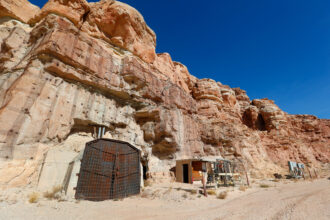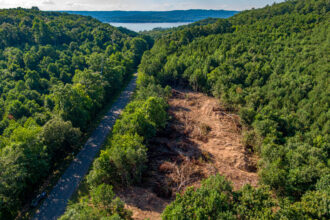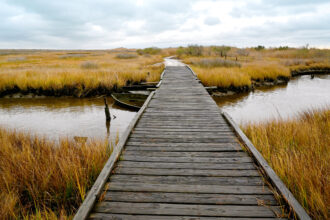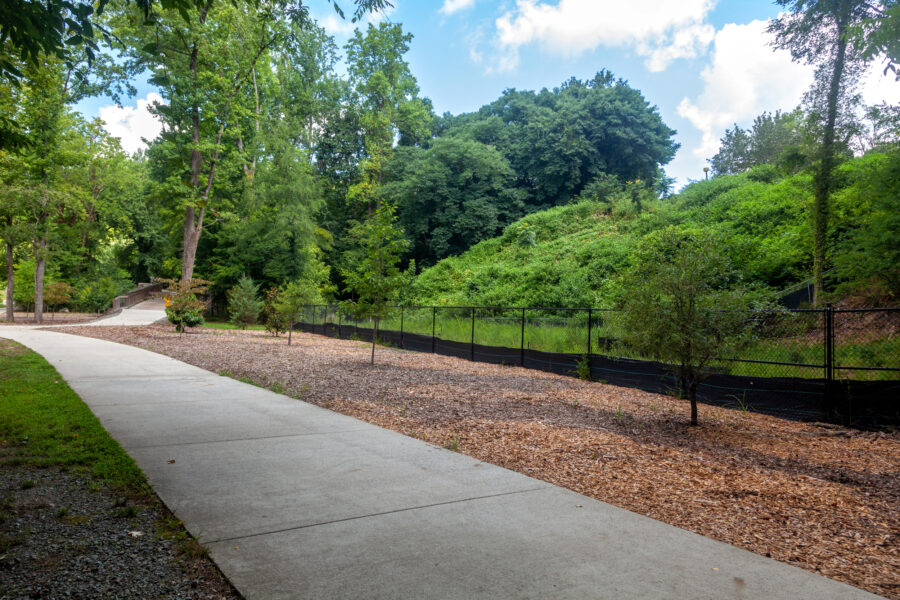PHOENIX—Members of environmental groups stood together in the lobby of the Arizona State Capitol Executive Tower late last month to deliver a petition to Arizona Gov. Katie Hobbs, requesting that she stop uranium mining activities near the Grand Canyon National Park.
The Sierra Club, Center for Biological Diversity, National Parks Conservation Association, Wild Arizona, Chispa Arizona and Haul No!, a group formed to fight the mining and transport of uranium, delivered a petition with more than 17,500 signatures to the governor.
They are seeking closure of the Pinyon Plain Mine, located less than 10 miles from the Grand Canyon. It is inside the Baaj Nwaavjo I’tah Kukveni—Ancestral Footprints of the Grand Canyon National Monument, which President Joe Biden established in August 2023. The removal of uranium ore from the mine started in late December.
Although the designation prohibits new mining claims and development, it allows prior claims with valid existing rights like Pinyon Plain to continue their operations. Energy Fuels Resources owns the mine, which is approximately 17 acres, and operates it on land managed by the U.S. Forest Service.
“This mine threatens to pollute the groundwater that feeds the seeps and springs in Grand Canyon, supporting plants, animals and people,” the petition states.
People can develop respiratory disease and toxicity in the kidneys due to uranium exposure, according to the federal Agency for Toxic Substances and Disease Registry. There are more than 500 abandoned uranium mines on the Navajo Nation, and the tribe continues to confront the ramifications of mining activities on tribal members and the environment. This includes advocating for federal money to clean up abandoned mines and compensation for former mine workers.
No one from Hobbs’ office met the group or accepted the written requests in person. Instead, the activists left the petition, the groups’ latest action attempting to get the Democratic governor’s attention, with the executive receptionist on the first floor. In January, the groups sent a letter to Hobbs urging her to revisit permits issued for Pinyon Plain Mine and seeking her help closing it. They said she has not responded to the letter.
A spokesperson with the governor’s office confirmed on July 11 that the petition was received.
“Gov. Hobbs will always put the health and safety of everyday Arizonans first. Pinyon Plain is one of the most closely regulated mines in the country, with an extremely stringent permit,” Liliana Soto, press secretary for the governor, said in a statement.

Energy Fuels Resources President and CEO Mark Chalmers said groups opposing the mine failed to prove their claims about the permitting process in court and are now conducting a “public disinformation campaign.”
“The Pinyon Plain Mine has been studied extensively for more than 30 years, with input from federal and state agencies, regulatory bodies and tribal stakeholders resulting in the issuance of all required permits for the mine,” Chalmers said in a written statement.
“Unfortunately, this smear campaign is designed to scare local and Indigenous communities by spreading misinformation and innuendo,” he said. “We are proud of the Pinyon Plain Mine and its role in reducing reliance on bad actors like Russia for the fuel that powers one of our best sources of carbon-free electricity.”
Vania Guevara is the advocacy and political director with Chispa Arizona, a program under the League of Conservation Voters that is dedicated to increasing Latinx voices in policies that address climate change and the environment. Guevara said it is urgent for Hobbs to address uranium mining because it threatens the health and safety of Indigenous communities.
A dozen tribes have ancestral, ceremonial and traditional connections to the region, including the Havasupai Tribe, Hopi Tribe, Hualapai Tribe, Kaibab Band of Paiute Indians, Las Vegas Paiute Tribe, Moapa Band of Paiutes, Paiute Indian Tribe of Utah, Navajo Nation, San Juan Southern Paiute Tribe, Yavapai-Apache Nation, Pueblo of Zuni and the Colorado River Indian Tribes.
Chispa Arizona helped collect signatures as part of its support of protections for the Grand Canyon. Its work includes organizing camping trips to the canyon for Maricopa County residents.
“Many of our community members don’t have the resources to camp or get up there,” Guevara said. “So, it’s something that we’re really passionate about, having access to public lands.”
During the petition delivery, Guevara was among those who held banners inside the tower’s lobby stating, “Shut down Pinyon Plain Uranium Mine,” along with an illustration of a ram skull with a radiation symbol, or trefoil, on its forehead.
“We support clean energy transition, but we never want it to be at the expense of the Earth, the environment or our Indigenous communities who are first and directly impacted,” she said.

Pinyon Plain Mine is situated above the Redwall-Muav Aquifer, the source of drinking water for the village of Supai on the Havasupai tribal land at the bottom of the Grand Canyon. The aquifer also feeds springs in the canyon. The mine is at the foot of Red Butte, a prominent peak sacred to the Havasupai.
“Those springs and streams are incredibly important to people and biodiversity, endangered species, the Havasupai Tribe, and neither industry nor regulators can ensure that uranium mining won’t permanently damage that water,” said Taylor McKinnon, the Center for Biological Diversity’s Southwest Director.
“The safe thing to do, the prudent thing to do, is to avoid that risk altogether and close the mine. Permanently harming the Grand Canyon’s aquifers and seeps and springs is not a risk that’s worth taking,” he added. “We need the governor to act.”
Although the mine is on federal public land, Carletta Tilousi, who is Havasupai, said Hobbs’ role as governor is significant in the effort to end Pinyon Plain because she oversees the Arizona Department of Environmental Quality, which administers the state’s environmental laws, and appoints that agency’s director.
This story is funded by readers like you.
Our nonprofit newsroom provides award-winning climate coverage free of charge and advertising. We rely on donations from readers like you to keep going. Please donate now to support our work.
Donate NowAdditionally, the department shares regulatory responsibility for certain federal programs delegated by the Environmental Protection Agency, according to the Arizona Secretary of State. This regulatory responsibility includes issuing air and water quality permits for Pinyon Plain Mine.
“ADEQ performs regular and thorough inspections of the mine, working closely with local and county partners, and stands ready to take appropriate action if violations are found,” Soto said in the statement from Hobbs’ office. “The state will also continually evaluate our procedures and safety requirements to ensure the mine is operating in a way that keeps our communities safe now and into the future.”
The Havasupai Tribal Council stated in January that they remain opposed to uranium mining in and around their tribal lands and the Grand Canyon.
“We feel that she needs to look deeper into what’s happening and what permits are being given to which companies,” Tilousi said. “These mining companies aren’t benefiting us at all. I don’t think they support anything in the state of Arizona. They just mine and leave.”
Because of increased pricing for uranium and support for nuclear energy to help address climate change, Energy Fuels Resources began extracting uranium ore last year at Pinyon Plain and two mines in eastern Utah. The company is preparing two more mines for production in Colorado and Wyoming this year, it announced in a news release in December.
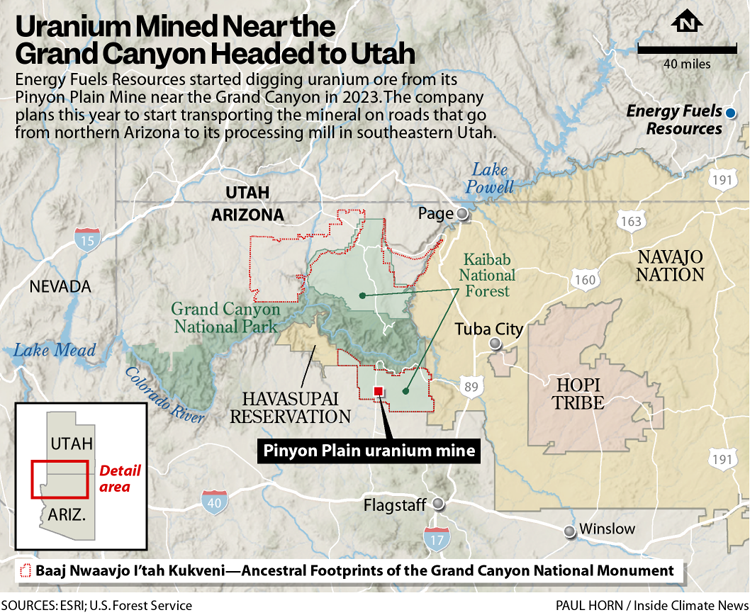
“The Pinyon Plain Mine is a small mine that will play a big role in providing domestically sourced uranium—the naturally occurring element that fuels safe, reliable and carbon-free nuclear energy,” Chalmers said.
He added that nuclear accounts for approximately one-third of the electricity used by Arizona residents to power homes, schools, businesses and electric vehicles.
Energy Fuels Resources plans to start hauling ore from the three operating mines to its White Mesa Mill near Blanding, Utah, where it will be stockpiled until processing begins in 2025.
Transporting the ore is another issue for Tilousi, who is a member of the White House Environmental Justice Advisory Council.
“My concern is the safety of the people on that road,” she said. “What happens when there’s a spill or a wreck or an accident? Who’s going to clean it up?”
Members of the Ute Mountain Ute Tribe oppose the transportation plan because several members live in the White Mesa community, which is adjacent to the mill site, while leaders and members of the Navajo Nation oppose the route because it crosses the tribe’s land.
Former tribal President Ben Shelly and the 22nd Navajo Nation Council enacted a law in 2012 that prohibits transporting uranium and other radioactive materials across the Navajo Nation unless it relates to the cleanup of past activities related to uranium mining and milling sites on the tribe’s land.
“What happens when there’s a spill or a wreck or an accident? Who’s going to clean it up?”
“The Navajo Nation has the right to exclude nonmembers and to condition their entry onto Navajo Nation lands and has the independent sovereign right and duty to protect the health, welfare and safety of the Navajo Nation and its citizens,” the tribal law states.
Energy Fuels Resources is authorized to use two routes that travel on state and federal highways, including those on Navajo land, according to Kaibab National Forest’s website. The roads are under the authority of the Arizona Department of Transportation, and the agency is not bound to comply with the tribe’s law from 2012.
In April, the Navajo Nation Council and tribal President Buu Nygren reiterated the tribe’s stance against uranium mining and associated activities. The resolution signed by Nygren includes a letter written by him and tribal council Speaker Crystalyne Curley to Biden that asks the president to use his executive authority to stop the planned transportation across the tribe’s land before it starts.
“Furthermore, we implore you to publicly support a legislative solution that would reinforce the sovereignty of tribal nations, enabling us to enforce our laws and protect our people,” Nygren and Curley wrote in the letter.
They also reminded Biden that Navajo leaders were “encouraged” by the establishment of Baaj Nwaavjo I’tah Kukveni national monument.
“Our support for the monument reaffirmed our stance against the transportation of uranium across Navajo lands, which not only endangers our communities but also contradicts our sovereign rights to enforce our laws and protect our territory,” the tribal leaders wrote.
In a news release on July 10, Nygren repeated the tribe’s position opposing trucks using roads on the Navajo Nation to deliver uranium to Utah.
About This Story
Perhaps you noticed: This story, like all the news we publish, is free to read. That’s because Inside Climate News is a 501c3 nonprofit organization. We do not charge a subscription fee, lock our news behind a paywall, or clutter our website with ads. We make our news on climate and the environment freely available to you and anyone who wants it.
That’s not all. We also share our news for free with scores of other media organizations around the country. Many of them can’t afford to do environmental journalism of their own. We’ve built bureaus from coast to coast to report local stories, collaborate with local newsrooms and co-publish articles so that this vital work is shared as widely as possible.
Two of us launched ICN in 2007. Six years later we earned a Pulitzer Prize for National Reporting, and now we run the oldest and largest dedicated climate newsroom in the nation. We tell the story in all its complexity. We hold polluters accountable. We expose environmental injustice. We debunk misinformation. We scrutinize solutions and inspire action.
Donations from readers like you fund every aspect of what we do. If you don’t already, will you support our ongoing work, our reporting on the biggest crisis facing our planet, and help us reach even more readers in more places?
Please take a moment to make a tax-deductible donation. Every one of them makes a difference.
Thank you,









